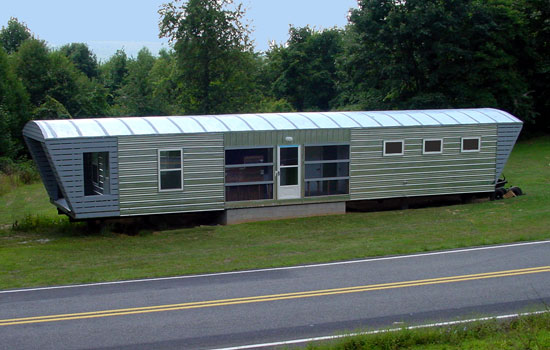
| Location | Adams County, Pennsylvania, USA |
| Date | 1997 |
| Client | Rural Opportunities |
| End Client | Single male migrant workers |
| Design Center | Design Corps |
| Design Team | Bryan Bell, Kindra Welch, Lesli Stinger, Melissa Tello |
| Additional Consultant | Gary Shaffer |
| Major Funding | American Institute of Architects, American Architectural Foundation, National Endowment for the Arts, Pennsylvania Department of Community and Economic Development |
| Cost per unit | $43,000 |
| Area | 740 sq. ft./69 sq. m |
A sign hanging above Bryan Bell’s desk reads, “The benefits of architecture are for everyone.”
It’s a motto that has defined his career. After earning his master’s in architecture from Yale, he landed a job in the offices of Steven Holl, but he soon felt restless. “I felt like I was doing plastic surgery when I wanted to be in the emergency room,” Bell said during a presentation in Austin, Texas.
During this time his sister, who worked with a nonprofit in Pennsylvania, told him about the appalling housing conditions in the area. Before long Bell found himself with Rural Opportunities, a community development nonprofit that had been serving the needs of farm workers and the rural poor since 1969. He struck a deal with them: If he could find funding for his services, they would hire him.
In 1997 Bell established Design Corps with the idea of bringing design services to people who ordinarily couldn’t afford to hire an architectural firm. The nonprofit design center has since become a clearing house for community-design ideas and methods and is best known for its innovative migrant housing. With research grants from the American Institute of Architects and the American Architectural Foundation, Design Corps partnered with Rural Opportunity Farmworker Advisory Councils to document the needs of farm workers in Adams County, Pennsylvania—many of them migrant. The team found that most earned less than $4,000 a year per family and lived in crowded dormitory-style “bullpens.” The mixture of many cultures and languages in one large room led to fights, and the close quarters also led to a high incidence of tuberculosis and other communicable diseases, according to the Migrant Health Program.
“One cannot just design a project and shove it into a community,” says Bell. In order to connect with and gain the trust of farm workers, Design Corps had to step out of the usual client-designer relationship and meet the workers on their terms.
As Sunday is the workers’ only day off, Design Corps set up stalls at local farmers markets. In return for filling out a questionnaire, workers received soda and bottled water—especially welcome on hot summer days. The questionnaires revealed that there were two types of workers: single men who came for a season and then returned to their home countries, and families in search of something more permanent.
To house the single men, Bryan wanted to pull away from the bullpen approach. Instead he looked at building several smaller units that could be premanufactured, ensuring a fixed price and preapproval of housing regulations. The resulting unit is a 720-square-foot (67-sq.-m) prefabricated metal building with two bedrooms, each sleeping four men, separated by a living room, a communal bathroom, and kitchen. To date, seven units have been constructed on farms in Adams County.

Prefabricated worker housing is delivered on the back of an oversize truck. Bryan Bell
Design Corps has worked to develop similar migrant-housing programs for both single men and families with farmers and workers on a nursery in Gray Court, South Carolina; on a mushroom farm in Kennett Square, Pennsylvania; and on an organic farm in Little Washington, Virginia. On the Little Washington farm the team overcame the challenge of poor septic facilities and water shortages by designing dwellings that contain greenhouse porches, where ginger lilies are grown using recycled gray water. Since the plants are pesticide free, the greenhouse provides an extra front porch for the workers among the fragrant flowers.
















READ OR LEAVE A COMMENT